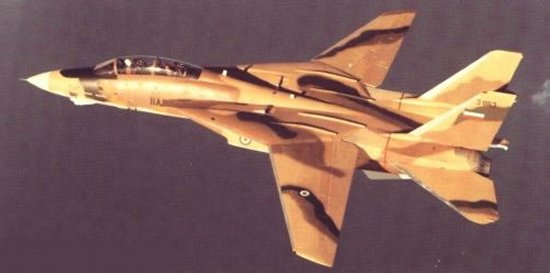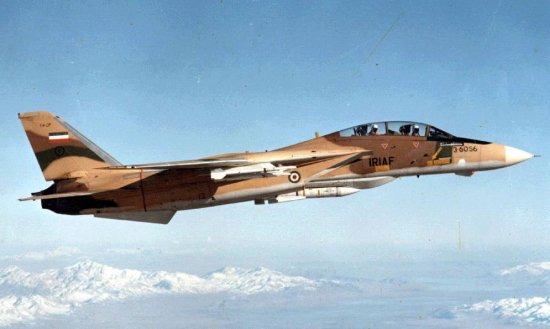|
||||||||||
|
|
||||||||||
|
||||||||||
|
|
||||||||||
I would like to know about the F-14A Tomcat used by Iran. How was it employed in the Iran-Iraq war. What
are the kills/losses figures? How many are left in service? Will they be upgraded? And is it true that
they were sabotaged so that they could not fire they Phoenix missiles? If yes, How?
- question from Sergei Ivanov
While service of the F-14 in the US Navy is well-known and well-documented, by the classic film Top Gun, at the very least, its operations with the Imperial Iranian Air Force (IIAF) and Islamic Republic of Iran Air Force (IRIAF) have largely remained a mystery. Under the pro-western Shah of Iran, the IIAF had benefitted greatly by interaction with the West, and Iran was able to purchase large amounts of sophisticated US military equipment to protect against the Soviet threat. By the early 1970s, the bulk of the IIAF was made up of Northrop F-5A and E, McDonnell Douglas F-4D and E Phantom II, and Lockheed P-3F Orion aircraft. However, none of these were able to ward off Soviet MiG-25 reconnaissance fighters that were making frequent flights over Iranian terrirory. This fact was made clear to US President Richard Nixon during his visit to Iran in May 1972 during which the Shah requested a means of intercepting the high-speed Soviet aircraft.

Having received permission from the US government, Iran decided to purchase the F-14 Tomcat over a competing F-15 Eagle offer. An intial order for 30 F-14s was signed in January 1974, and this number was later increased to 80. The first of these aircraft arrived in Iran in January 1976, differing only from their American counterparts in the removal of certain classified avionics systems. These aircraft were also fitted with the improved TF30-414 engine, standard on later production models. Twelve aircraft were delivered by May 1977, and one of these was used to shoot down a BQM-34E target drone flying at 50,000 feet with an AIM-54 Phoenix missile in August of that year. This successful demonstration quickly convinced the Soviets to end the MiG-25 overflights. Deliveries continued until 1978 when the 79th unit was delivered, one example remaining in the US as a testbed (this plane was later transferred to US Navy flight test duties at the Point Mugu Naval Air Station following the Revolution). Some 714 Phoenix missiles were also ordered, but only 284 of these were delivered by the time of the Iranian Revolution in 1979.
Following the overthrow of the Shah and the ascension of Ayatolla Khomeini to power, the new government cancelled further contracts for Phoenix missiles and other Western arms. Continuing decay in relations with the US led Pres. Carter to impose an arms embargo on Iran that still continues today. Without Western contractor assistance, a lack of spare parts and maintenance support quickly degraded the ability of the IRIAF to operate its fleet of US-built aircraft. Fundamentalist purges of Air Force officers, pilots, and personnel who were perceived to support the Shah further worsened the situation.
In addition to the effects of the embargo itself, rumors suggest that all 77 remaining Tomcats (two had been lost in 1977 during training flights) were somehow sabotaged so that they could no longer fire their Phoenix missiles. Whether or not these rumors have any merit to them is debated, as is the identity of who may have performed this sabotage and how. Various accounts credit the act to either departing Grumman technicians or Iranian Air Force personnel friendly to the US. Perhaps the simplest and most effective means of performing this sabotage would have been to remove or somehow corrupt the software in the aircraft's flight computer that interfaces with and commands the missiles, but there is no proof this was done. Some sources even go so far as to claim that Iranian revolutionaries performed the sabotage as revenge against an Air Force perceived to be pro-Shah, but this seems very unlikely given the technical skill required.

Regardless, the IRIAF was in a rapid state of decline by the time the Iran-Iraq War began on 22 September 1980. Due to the poor state of both air forces, air power played little role in the conflict. Early air battles tended to favor the Iranians whose pilots were better equipped and trained, but the lingering arms embargo and repeated purges of experienced personnel continued to reduce the nation's air capabilities. Meanwhile, Iraq took delivery of Dassault Mirage F1s armed with Matra R-550 Magic air-to-air missiles that steadily improved the nation's effectiveness in the air.
As for the F-14s, only a small number were ever airworthy at any given time (generally 10 to 20) and these were typically kept out of combat. They were most often used as airborne early warning platforms owing to the design's powerful radar, and were therefore deemed too valuable to risk in air-to-air combat. In this role, the planes were sometimes defended by F-4E and F-5E fighters. At least some F-14s were lost in action, but the claims of the two sides are in poor agreement, as is always the case in warfare. Iraq claims some 11 kills:
The US has estimated the number of operational Iranian F-14s at any given time at 15 to 20, and sometimes less than 10, due to the cannibalization of other planes to keep a few flying. Iran claims a much higher number, of course, and was indeed able to assemble 25 aircraft for a flyby over Teheran on 11 February 1985. By whatever means, Iran has been able to maintain a steady supply of spare parts for its F-14s, F-4s, and F-5s in spite of the embargo. Some of these parts may have been supplied through the arms-for-hostages deal that was revealed during the Iran-Contra scandal. Other sources claim that parts may have been smuggled through collusion with Israel. Some parts are also manufactured domestically by Iranian Aircraft Industries, and Iran has even gone so far as to claim that 100% of the parts required to keep the aircraft operational can be produced domestically. Nonetheless, US intelligence places that value closer to 70%, and a number of foreign nationals have in fact been implicated in efforts to illegally smuggle aircraft components from the US to Iran. Two men were so charged in December 2000 for attempting to illegally purchase F-4, F-5, and F-14 parts and ship them to Iran by way of Singapore. A fugitive named Houshang Amir Bagheri is also listed on the US Customs Most Wanted list for his attempts to acquire classified F-14 components on behalf of Iran.
While Iran has managed to keep at least a portion of its Western aircraft in service, the status of the vaunted Phoenix missile is still debated. Most sources indicate that none were used during the Iran-Iraq War owing to their supposed sabotage while others claim that up to 25 Iraqi planes were downed by AIM-54s before Iran exhasuted its supply in 1986. Regardless, the aircraft is still able to fire AIM-7 Sparrow and AIM-9 Sidweinder missiles, and typically carries four AIM-7s and two AIM-9s for air-to-air operations. Iran is reportedly developing a domestic version of the Sparrow to replace its stock of expended missiles.
It is also believed that one or more F-14s were delivered to the Soviet Union in exchange for technical
assistance. In addition, at least one Iranian F-14 aircrew was reported to have defected to the Soviet Union with
their aircraft. Some believe that Soviet access to Iranian Phoenix missiles allowed the Vympel Design Bureau to
develop the R-33/AA-9 Amos long-range missile that equips the
MiG-31,
but chief designer Gennadiy Sokolovskiy has indicated that his team never had such access. In any event, it is
believed that Soviet and Russian expertise has allowed Iran to operate, maintain, and upgrade the F-14 fleet. The
aircraft are reportedly being upgraded with a new Russian radar, engines, and a glass cockpit allowing them to
serve until well into the 21st century. The Iranian press has further indicated that the surviving aircraft have
been adapted for a heavy bombing roll, perhaps armed with air-to-surface anti-ship missiles. Some 50 to 55 are
believed to remain in service, but only about 30 of these are considered airworthy at any one time.
- answer by Greg Alexander, 12 May 2002
Related Topics:
Read More Articles:


|
Aircraft | Design | Ask Us | Shop | Search |

|
|
| About Us | Contact Us | Copyright © 1997-2023 | |||
|
|
|||